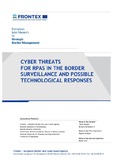Cyber Threats for RPAS in the Border Surveillance and Possible Technological Responses
Kokkuvõte
Advances in technology tools for research, monitoring and control of the borders have led to the emergence of Remotely Piloted Aircraft System (RPAS) as the new response to any kind of cross border crime and illegal migration. This system is less expensive than any other system used up to now to control the border from the air, can fly for up to 24 hours covering thousands of nautical miles and can be moved from one place to another in a very short time. It seems to be the perfect solution to patrol the border, but in the last few years some incidents have happened to this system causing some doubts to arise regarding the cyber security. The purpose of this research is to identify and evaluate, through in-depth analysis and interviews, all cyber threats to the RPAS engaged in maritime patrol activities. Among these, the threat with the highest risk for border surveillance activity in Italy will be identified and finally possible technological answers will be provided to mitigate the risk.
Kirjeldus
3. Introduction ; 4. Literature review ; 4.1. Remotely piloted aircraft system ; 4.1.1. Overview of the system ; 4.1.2. Brief overview of the electromagnetic waves ; 1. Amplitude (distance between the propagation line and the wave crest) ; 2. Wavelength (distance between two corresponding points of two successive waves) ; 3. Frequency (oscillations per second) ; 3.1.1. Classification of RPAS ; 3.1.2. Field of application ; 3.2. Type of attacks ; 3.3. Cyber attack and risk assessment for RPAS models ; 3.3.1. Risk assessment for RPAS models ; 3.3.2. Risk assessment in aviation ; 3.3.3. Risk assessment for technology system ; 3. Methodology ; 3.1. Research strategy ; 3.2. Research Project ; 3.3. Data collection and/or use of data ; 3.3.1. Description of the Table fulfilled by the Expert in cyber security ; 3.4. Data analysis ; 3.5. Sample Strategy ; 3.6. Research quality indicators ; 3.7. Ethical considerations ; 3.8 Limitations ; 4. Analysis of the table ; 4.1. Opinion of the Expert in Cyber Security ; 4.1.1. Threat, Vulnerability and Likelihood for “RPA” ; 4.1.2. Threat, Vulnerability and Likelihood for “CGS” ; 4.1.3. Threat, Vulnerability and Likelihood for “SATELLITE” ; 4.1.4. Threat, Vulnerability and Likelihood for “LoS” ; 4.1.5. Threat, Vulnerability and Likelihood for “RLoS” ; 4.1.6. Threat, Vulnerability and Likelihood for “BLoS” ; 4.2. Expert in Border Surveillance ; 4.3. Results vs literature ; 4.3.1. The threat identified and which known in the academic word ; 4.3.2. Consequences of a cyber attack in the literature ; 4.4. Identification of the main threats ; 4.4.1. Risk assessment table ; 4.4.2. The "Jamming" ; 4.4.3. Possible countermeasures against jamming ; 5. Discussion of results, conclusions and recommendations



